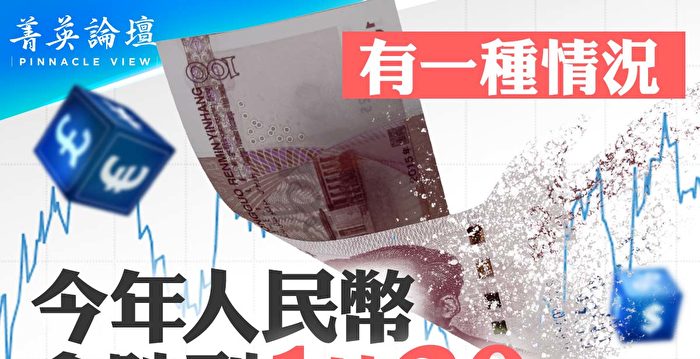Will the RMB depreciate significantly this year? How did the 50% depreciation of the RMB in 1994 trigger the financial crisis in Southeast Asia? The economic structure is unstable. Can the CCP withstand the sharp fall of the renminbi? (Provided by “Elite Forum”)
[The Epoch Times, February 18, 2024]China has stopped its city-wide lockdown policy in 2023. Many people thought that mainland China’s economy would gradually recover, but in fact, China’s economy is deteriorating. Although the official GDP growth rate was 5.2% through a new falsification method of reducing the previous year’s output value, in terms of US dollars, the Chinese economy still experienced negative growth for the first time in more than 20 years. Some analysts believe that the RMB may fall even more this year, and the exchange rate against the US dollar may even fall above 1:20. If so, what impact will this have on all Chinese people and on Chinese and international economic activities?
How is the RMB/USD exchange rate 1:20 calculated?
Taiwanese macroeconomist Wu Jialong said in NTDTV’s “Elite Forum” program that there is a view that theoretically the current exchange rate of the US dollar against the RMB should exceed 1:20, almost 1:22. This concept does not come from funds. The exchange rate theory is not based on the flow movement, hot money movement, and international capital movement, but the exchange rate theory derived from the evaluation of purchasing power, which is the ratio of GDP to M2 (broad money supply). GDP is the denominator, and the numerator is the broad money circulation indicator M2. This ratio means that when I produce a unit of GDP, the price you use to trade it is the unit transaction price. Then the ratio of the unit transaction prices of the two countries is converted into the exchange rate.
Let’s do the math based on the current exchange rate of 7.2 USD/CNY as a benchmark. In 2023, China’s additional currency issuance converted into U.S. dollars will be 40 trillion U.S. dollars, and the U.S. side will be 20 trillion U.S. dollars. China is twice that of the United States. China’s GDP in 2023 converted into US dollars is 17.8 trillion, and that of the United States is 28 trillion. China’s GDP is 64% of that of the United States, which is 0.64. The currency issuance is twice that of the United States, and the GDP is 0.64 that of the United States. If you calculate it this way, you divide 2 by 0.64 and you get 3.125. This is the change in economic competition between the United States and China in 2023. Then based on the current exchange rate of 7.2 multiplied by 3.125, it is calculated to be 22.5. This algorithm means that 1 US dollar can theoretically be converted into 22.5 yuan. If there is water in GDP, everyone knows that, especially in China, there is a lot of water, so theoretically, the RMB exchange rate should depreciate even more.
The problem now is that this is just a theory of purchasing power evaluation, and it is quite outdated to use purchasing power evaluation now. This theory is actually not as good as the capital movement theory. Secondly, China now has a lot of capital controls and no freedom of exchange, so this theoretical value is greatly reduced and is just a purely reference point of view. On the other hand, from the perspective of capital flow theory, because of strong capital controls, you do not have the freedom to exchange foreign exchange, so this theoretical value cannot be fully demonstrated. Therefore, the RMB will theoretically depreciate, but this devaluation is not yet visible.
China’s foreign exchange is controlled and the RMB exchange rate does not reflect the real economic relationship
“The Epoch Times” editor-in-chief Guo Jun said in the “Elite Forum” that economics does have a formula for judging currency exchange rates, which is mainly measured by data such as currency issuance, national debt, and total import and export volume. If measured according to these data, the RMB/USD exchange rate should indeed be around 1:20. But this formula is an ideal state, and it has some assumed preconditions. The most important condition is that the currency is completely liberalized, the government does not intervene at all, and funds can flow freely, whether it is current account or capital account funds. . But in fact, most countries do not fully meet this ideal state, and there are not many countries that fully meet this condition. As far as China is concerned, it is basically a country with a high degree of government control. Basically, the more government control there is, the less applicable this formula may be.
Let me give you an example: in 1980, the U.S. dollar to RMB ratio was 1:2.5. Everyone knows that this does not mean that China’s economy was good at that time. The actual situation was that China’s economy was very poor at that time. China implemented complete and thorough controls on foreign currency, so the official exchange rate at that time had no meaning to ordinary people, nor did it mean anything to ordinary companies.
China’s current foreign exchange controls are indeed much looser than those at that time. China is now the country with the largest foreign exchange reserves, with 3 trillion US dollars, but it is still one of the countries with the most stringent foreign exchange controls in the world. This control will Some changes and adjustments may occur based on circumstances. That is, if the authorities deem the situation extremely urgent, they can adopt stricter control measures, or even go back to the period of complete foreign exchange controls in the 1980s. Theoretically speaking, if it is a complete control and every dollar in and out is controlled, the official can quote any exchange rate, including 1:1 US dollar to RMB, or even 1 RMB to 10 US dollars. This is of course an extreme situation, because trading is controlled, and the result is that funds in and out are completely frozen, and no one will trade with you. Therefore, when we discuss the RMB exchange rate, there is a prerequisite, that is, the official control method of the Chinese Communist Party does not change and is similar to the current situation. We will discuss it on this premise.
Guo Jun said that although there is a big gap between theory and practice, this discussion is still meaningful. We must know on what basis the CCP adjusts the loosening or tightening of foreign exchange controls. When the CCP joined the WTO, one of its promises was to liberalize capital account controls in 15 years, and should be completely liberalized by 2016. In fact, it has not been liberalized, but relatively speaking, the control was indeed looser in 2016, and the control has become increasingly strict since then. First, there are controls on enterprises and foreign investment; then there are various technical restrictions on the divestment of foreign-owned enterprises, which are all restricting the foreign exchange categories of capital projects; then there are also restrictions on the use of foreign exchange by residents, with only 50,000 exchanges allowed per year. US dollars, that is, starting to limit current items.
Essentially, the exchange rate of a currency is the price at which one currency is used to buy another currency. The essence of price is the relationship between supply and demand, which is the principle of the market. However, if there is price control and there is a buying and selling monopoly, the price may not reflect the relationship between supply and demand. So we see that the RMB exchange rate, whether onshore or offshore, does not truly reflect the relationship between supply and demand. In the 1980s, the official quotation of USD/RMB was 2.5 RMB, but the black market price at that time was 6 RMB, and at most it rose to 12 RMB. The black market price is actually one of the important reference indicators for us to refer to the people’s exchange rate.
Guo Jun said that Hong Kong people often use water to describe money. Water flows to low places, while money flows to places with low costs and low risks. Therefore, China’s capital outflows are serious, which means that China’s risks have become higher and the asset cost of funds has become higher and higher. Many of these are political factors, not just economic factors per se. To put it simply, if everyone expects the CCP’s foreign exchange controls to become more and more stringent, then the speed of capital flight will increase and the pressure on the RMB exchange rate will increase. Of course, the stronger the control, the more active the black market will be.
The depreciation of the RMB once led to the financial crisis in Southeast Asia, but the situation is very different today.
Wu Jialong said in the “Elite Forum” that the sharp decline of the RMB in the past has had two impacts on the global economy. The first is that the depreciation of the RMB will cause China to export deflation. For other countries, it will become very cheap to import things from China. The second is that devaluation will create an expectation psychology. If everyone expects the RMB to depreciate, then this expectation psychology will affect the movement of international funds, and funds will leave the RMB and escape from the RMB. Such a result will impact the foreign exchange reserves of the Central Bank of China. .
So the central bank has two options at this time. One is to guard the exchange rate, which is to throw out foreign exchange reserves to defend the exchange rate and avoid devaluation. The other is to defend foreign exchange reserves, hold on to foreign exchange reserves, and let the exchange rate depreciate. How to use these two countermeasures? The central bank will balance the risks. If the exchange rate can be maintained, I will throw out some foreign exchange to defend and the depreciation expectations will disappear. Then this can be done. If I sell foreign exchange reserves, the exchange rate cannot be defended and the exchange rate cannot be defended. At this time, it would be a waste for me to sell foreign exchange reserves. Therefore, it must balance this risk. It is very likely that when it switches from guarding the exchange rate to guarding foreign reserves, it will be equivalent to letting the exchange rate depreciate.
Let’s talk about what happened in January 1994, because starting from February, the Federal Reserve began to enter an interest rate raising cycle. From February 1994 to February 1995, the official benchmark interest rate rose from 3% to 6%, an increase of one year. 12 points, that was a very famous interest rate increase, called the Bond Massacre, which caused the value of bonds to plummet. One month before the Fed raised interest rates, in January 1994, China had already felt a lot of capital withdrawing from emerging markets. As a result, something happened. The RMB devalued sharply. In January 1994, it depreciated from 1:5.8 50% means a reduction of 2.9 percentage points to 1:8.7. What impact does this have? This factor caused the subsequent Southeast Asian financial crisis. After the devaluation of the RMB in 1994, China’s export competitiveness increased significantly, seizing all export opportunities in Southeast Asia’s export markets.
Southeast Asian countries were originally called the Four Little Tigers at that time, and they were preparing to enter the international market and start taking over the performance like the Four Tigers. As a result, it was intercepted and intercepted by China. Therefore, the trade surplus in Southeast Asia later reversed, and finally capital began to flee, and then the financial turmoil in Southeast Asian countries such as Thailand, Malaysia, and Indonesia came from the sharp depreciation of the RMB in January 1994.
After the RMB depreciates sharply, there will be an additional phenomenon or effect, which is called being sheared. That is, China’s high-quality assets will become very cheap in the eyes of foreign investors due to the sharp depreciation of the RMB. At this time, foreign investors will come in to harvest leeks. Buy that quality asset. When this high-quality asset returns to normal prices in the future, foreign investors will make a lot of money. So now the international financial giants are waiting for the RMB to plummet and depreciate significantly. At that time, a large amount of funds will come back to China to pick up bargains.
Shi Shan, senior editor and chief writer of The Epoch Times, said in the “Elite Forum” that this may depend on the political environment at the time. If China is in chaos, others will not pick it up, and this ready-made thing may fall even further. Now it seems that the issue of RMB exchange rate is not only an economic issue, but also many political issues. Will China’s current economic structure be as stable as it was in the 1990s? I’m afraid it’s hard to say whether China’s economic structure can withstand big fluctuations once they occur. This is very difficult to say. If such a large-scale fluctuation occurs again in the future, it is likely to affect many aspects of mainland China, not only economic problems, not only ordinary people’s wealth problems, but also the entire political and social structure may be greatly affected.
The new TV program “Elite Forum” launched by NTDTV and The Epoch Times is a high-end TV forum based in the Chinese world. The program will bring together elites from all walks of life around the world to focus on hot topics, analyze the general trend of the world, and provide viewers with relevant social affairs and history. An in-depth look at the truth.
Please watch the entire content of this issue of “Elite Forum” online.
“Elite Forum” production team
Editor in charge: Li Hao#
2024-02-18 04:57:54
#Elite #ForumWill #RMBUSD #exchange #rate #fall #Epoch #Times


